Abstract
Starting to train swimmers at an early age, as well as continuous training during the growth stages should target the achievement of the best results at both junior and senior levels. Considering the functional and somatic characteristics of pubertal swimmers, the training plan involved the use of workouts structured on metabolic training zones similar to those used at the senior level swimmers. The experiment aimed to highlight the effects of training methods based on the model for senior swimmers on the aerobic capacity of pubertal swimmers. Through advanced methods of monitoring the effort made by pubertal swimmers during training, we collected data which were then processed using statistical and mathematical methods. The analysis of the results from T-2000 Test before and after the observation period showed an average improvement of 40 seconds, indicating that the training plan based on training zones similar to the senior level swimmers produced a development in the aerobic capacity of the pubertal swimmers.
Keywords: Training zones, effort monitoring, pubertal swimmers, aerobic capacity, T-2000 Test
1. Introduction
Successful sports performance implies serious and well-coordinated training, which should use the
biological possibilities of the athlete as efficiently as possible. For this reason, the coach is compelled
to adapt the effort parameters depending on the functional and somatic characteristics of the swimmers’
age indicators, in order to obtain the best results and not to cause health problems.
“Aerobic training or cardiorespiratory endurance training improves central and peripheral blood
flow and enhances the capacity of the muscle fibers to generate greater amounts of adenosine
triphosphate” (Wilmore, Costill, & Kenney, 2008: 222).
Aerobic training is largely considered to be the most important aspect of physical fitness, and “all
athletes can benefit from maximizing their endurance” (Wilmore, Costill, & Kenney, 2008: 245).
According to Olbrecht (2000), “the better the aerobic system is developed, the more oxygen can be
used and the faster one can swim during prolonged exercises. Aerobic capacity is therefore the major
factor determining performance in long distance event”.
Aerobic effort capacity refers to the body’s possibilities to carry out sub-maximal moderate effort,
and to maintain it as long as possible through aerobic metabolism (oxidative phosphorylation) of the
carbohydrate and lipid sub-layer.
Access to new information about specific swimming effort has led to the division of effort into
areas with maximum influence on several biological factors. Marinescu (2003: 65) argues that the
“translation from the notion of distance to the notion of time has resulted in zones of effort in preparing
swimmers, and this zoning is based on energy sources specific to the try-out”.
We developed a 3-month training plan, during which we used both classical and metabolic aquatic
training methods. This allowed us to schedule the effort in different areas and monitor it afterwards
with the help of telemetric equipment and by measuring blood lactate concentration.
In order to determine the efficiency of using effort zones, the subjects were tested at the beginning
and the end of the observation period, with the intent to calculate the degree of improvement in their
aerobic capacity.
The main objective of this research paper is to obtain conclusive data on the influence and
efficiency of training effort zoning on the aerobic capacity of a group of pubertal swimmers, in order to
achieve improved performance in competitions.
1.1. Hypothesis
The physical effort carried out by pubertal swimmers, aged 12-16, during aquatic training can be
divided into effort zones, depending on their heart rate and blood lactate concentration, following the
model used in preparing seniors to improve their aerobic capacity.
2. Materials and methods
In developing this paper, we used the experimental method, controlled observation, testing method
(T-2000 Test), graphical method, and statistical and mathematical method with the following indices:
mean, standard deviation and variance.
2.1. Duration, location and subjects
The research took place at Aqua Team Sports Club of Bucharest. The study lasted 84 days, starting
on 15 September 2014 and ending on 7 December 2014. The subjects were 5 pubertal swimmers, aged
between 12 and 16 years. The participants were at that time components of Aqua Team Sports Club,
Bucharest. The club has 5 teams with a total of 120 athletes, aged between 5 and 16 years. They were
the first generation of club juniors and they all hold national championship titles in various try-outs.
2.2. The test
The T-2000 Test (Maglischo, 2003) was used to test changes in aerobic capacity of the swimmer.
This involves that the swimmer should swim as fast as possible a distance of 2000 metres, and the lap
times in every 100 metres to be equal between them.
The times for every 100 metres should correspond to the anaerobic threshold, the swimmer being
compelled to maintain this speed throughout the test. In the eventuality that there is a difference bigger
than 4 seconds between the fastest and the slowest 100 metres, the result of the test is disregarded. The
final time after 2000 metres is recorded.
2.3. The device/equipment used
The G.T. Aqua Hosand telemetry system is unique in the world and offers the possibility of
monitoring heart rate values of up to 32 swimmers in real time. All data were collected with a Heart
Rate Monitor (HRM) placed on the swimmer’s chest and transmitted by a transmitter to the central unit
(PC, laptop).
The data received is processed by special software: MCSoft. In addition to recording the heart rate
in real time, this software enables the division of data into effort zones and the acquisition of statistical
reports regarding the effort monitored.
Coupled with the use of the heart rate monitoring system, we used a device for measuring blood
lactate concentration. Lactate Meter Plus is a Nova Biomedical product which is characterized by a
high-speed of analysis (13 seconds) and a maximum deviation of 0.2mM.
The telemetry system software has a function of zoning effort through five different colours. These
can be set up manually by the user, taking into account the biological peculiarities of the group of
athletes:
Green – aerobic threshold Light Yellow – slow anaerobic threshold Dark Yellow – anaerobic threshold Pink – maximal oxygen consumption Red – anaerobic endurance
3. Results
In Table 1, we can see that during 13 weeks the participants swam a total of 974,000 metres. Also,
in Table 2, Figure 1 and Figure 2, we highlighted the volume swum in each zone of effort.
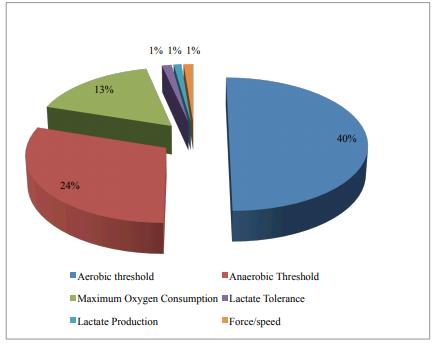
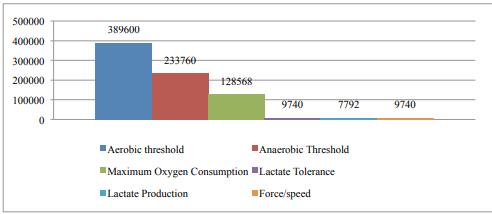
In Table 3 and Figures 3,4, 5 and 6, we can observe the data acquired with the effort monitoring
equipment throughout the training session. These represent the physiological responses of the pubertal
swimmers’ bodies to training sets which aim at different effort zones. The sets were standardized in
order to bring continuity in training and the possibility to observe the swimmers’ adaptation to their
requirements.
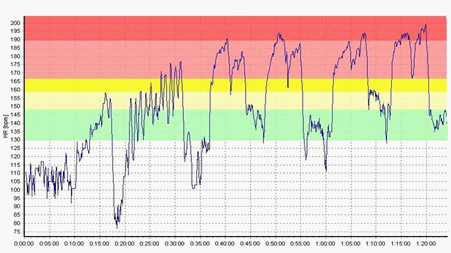
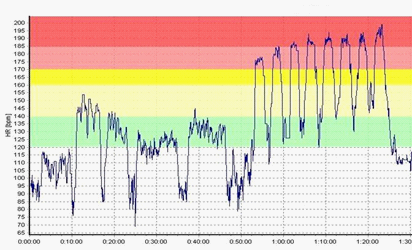
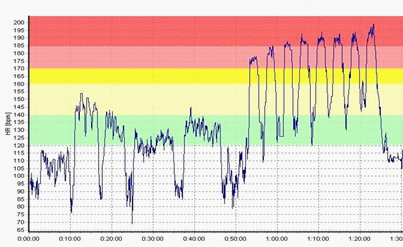
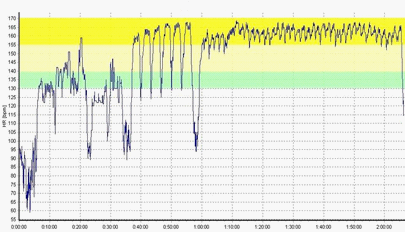
From Table 2, we can observe an improvement of the results in the final assessment for all five
subjects. They swam in the second evaluation an average of 40s faster than in the first one. The biggest
progress was registered by the participant C.G., with 56 seconds. The smallest progress was registered
by the participant V.T., with 30 seconds (Fig. 7).
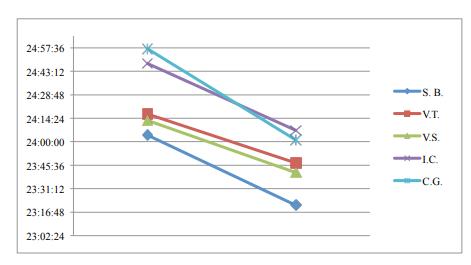
4. Discussions and conclusions
The division of physical effort carried out by pubertal swimmers during aquatic training on the
model used for senior athletes offers the coaches an efficient way of enhancing the aerobic capacity.
Analysing the results obtained through the T-2000 test, we can conclude that the swimmers have
improved their aerobic capacity, as indicated by a decrease in total swimming time with an average of
40s.
Thus, by rational and rhythmic use of training methods based on zoning efforts throughout the
observation period, we achieved the improvement of the aerobic capacity in all of the subjects
research hypothesis is confirmed.
Also, by using advanced methods of monitoring the effort made by pubertal swimmers during
training, coaches can conduct workouts with greater accuracy in order to fulfil the training objectives.
The methods we have used are easy to implement in training pubertal swimmers. This helps them keep
their pleasure for long hours in the pool and their interest in competitive sports.
References
Maglischo, E. W. (2003). Swimming Fastest. Champaign, IL: Human Kinetics.
Marinescu, Gh. (2003). Natație - efort și antrenament. București: BREN.
Olbrecht, J. (2000). The Science of Winning. F & G Partners.
Wilmore, J. H., Costill, D. L., & Kenney, W. L. (2008). Physiology of Sport and Exercise. Champaign, IL: Human Kinetics.
Copyright information

This work is licensed under a Creative Commons Attribution-NonCommercial-NoDerivatives 4.0 International License.
About this article
Publication Date
10 June 2016
Article Doi
eBook ISBN
978-1-80296-010-5
Publisher
Future Academy
Volume
11
Print ISBN (optional)
-
Edition Number
1st Edition
Pages
1-509
Subjects
Sports, sport science, physical education
Cite this article as:
Marinescu, G., Radulescua, A., & Ticala, L. (2016). The Utilization of Metabolic Training Zones in Pubertal Swimmers. In V. Grigore, M. Stanescu, & M. Paunescu (Eds.), Physical Education, Sport and Kinetotherapy - ICPESK 2015, vol 11. European Proceedings of Social and Behavioural Sciences (pp. 293-300). Future Academy. https://doi.org/10.15405/epsbs.2016.06.40

